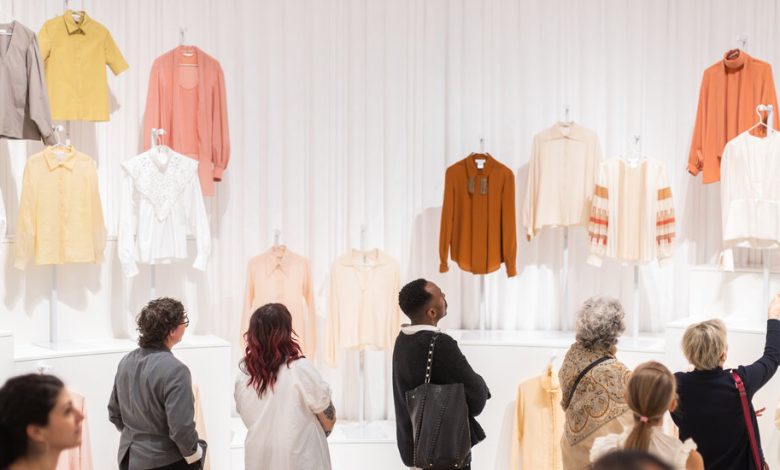In Chloé Show, an Unseen Legacy With Quiet Jewish Roots

For only the second time in its almost 120 years, the Jewish Museum is holding a fashion exhibition — and it is the first in New York dedicated to Chloé, the French ready-to-wear brand founded in 1952 by the Egyptian-born designer Gaby Aghion. “Mood of the Moment: Gaby Aghion and the House of Chloé”seeks to rectify both oversights, while introducing its founder, and her connection to her own Jewish identity, to the broader public.
Born Gabrielle Hanoka in Alexandria in 1921, Aghion moved to Paris in 1945, after her marriage to Raymond Aghion, and opened Chloé — named for a friend — in 1952, at a time when designer-dictated couture (made-to-order clothes for the elite) still dominated the French fashion scene, and Jewish roots were kept relatively quiet. Though she wasn’t formally trained, Aghion, who identified as a Communist, believed women needed something easier — chicer, simpler, more whimsical — to wear every day, and she set out to offer them just that, hiring an assortment of talented young designers to realize her vision and setting a template that would define the brand.
In 1966 Karl Lagerfeld joined the house, working closely with Aghion until 1983; in 1987, after Aghion sold the brand to the Richemont Group, Martine Sitbon stepped in as creative director, to be followed by Lagerfeld again (1992-1997), and seven more designers, including Stella McCartney, Phoebe Philo and Clare Waight Keller. Aghion died in 2014, but the “Chloé girl” she created lived — and lives — on.
The exhibition seeks to foreground Aghion at the brand, repositioning Chloé as a historically important fashion name and giving the museum a pop culture edge. Whether it succeeds was the subject of a debate between Vanessa Friedman, the chief fashion critic for The New York Times, and Max Lakin, a contributing culture critic.
VANESSA FRIEDMAN Fashion shows in New York tend to land at the Met, the Brooklyn Museum, or specialist institutions like the Fashion Institute of Technology, which makes this show something of a black swan. So what exactly is going on here? Do you think this is a teachable moment about cultural preconceptions, an effort by the museum to reach a new audience, or both?
MAX LAKIN This is what intrigued me about siting this here. The Jewish Museum has mounted art-historically important exhibitions, though as you say, infrequently about fashion (their first was a buoyant Isaac Mizrahi survey in 2016). Yet this show only really addresses Aghion’s Jewishness — and, for that matter, Aghion herself — sidelong, despite her being the nominally animating principle.
Aghion’s biography basically takes up half of the first gallery, with photos of her lolling among the desert dunes of her youth, after which the show becomes a mostly linear brand history, from boutique upstart to global industry player. I don’t necessarily think this is a curatorial failure: like the majority of diasporic Jewry, Aghion was largely secular; most designer-entrepreneurs did not foreground their Jewishness. (“Ralph Lauren” is of course the savvy Anglicization of Ralph Lifshitz.) She subsumed her own identity in the Chloé name, an invention she chose mostly because she liked the way the roundness of the letters looked together. Despite its consumer popularity, Chloé is relatively understudied, no?
FRIEDMAN Very understudied. In part, that’s because museums tend to be either interested in fashion as: 1) an art form, or a textile art form, which means couture: the super-fancy clothes made for the very few; or 2) an expression of a sociocultural trend, in which case work from different brands makes the argument. It’s rare for one show to focus on a single ready-to-wear brand such as Chloé. Yet that’s what the Jewish Museum is doing, and it suggests that brand has something very important to say. But beyond simply giving Gaby Aghion credit where credit is due — here is a Jewish female entrepreneur in a fashion world where those three words rarely get acknowledged as going together — what, exactly, is that?
After seeing the show I’m not sure. The exhibition moves on from its founder fairly quickly through nine (count ’em!) other designers for the label, only one of whom identifies as Jewish (Stella McCartney) and two of whom were men.




Guess the Chloé designer and the year (clockwise from upper left): a hand-painted silk crepe by Karl Lagerfeld, 1967; chiffon by Clare Waight Keller, 2016; a T-shirt and fringed skirt by Natacha Ramsay-Levi, 2019; and a parka by Gabriela Hearst and Sheltersuit, 2021.Credit…Chloé Archive, Paris; Photo by Julien T. Hamon/The Jewish Museum
LAKIN It’s instructive to follow the progression of the design that’s touched so many points of culture and how tastes have changed, but it’s also very clearly brand service — the bulk of the show is directly from the Chloé archive — though it is not reminiscent of the kinds of “exhibitions” Vuitton or Gucci have given themselves in recent years, which are really walkable marketing campaigns. This is a sober exhibition with an argument, which is that an enormous part of fashion history — Lagerfeld and McCartney and Philo — doesn’t happen without Aghion.
FRIEDMAN At least the show is not actually sponsored by Chloé, the way the recent Dior extravaganza at the Brooklyn Museum was underwritten by Dior, so it’s not a brand advert, which is a good thing (the sheer fact that there is no part of the show devoted to perfume is a huge relief).
LAKIN It also credits Aghion with “elevated ready-to-wear” which predated Saint Laurent, and which is compelling. The fact that this is the legacy of a Jewish woman largely becomes subtext.
FRIEDMAN That is actually more than compelling — it’s potentially revolutionary. Saint Laurent, as you point out, is generally credited with creating ready-to-wear when he opened his Rive Gauche boutique in 1966, but Aghion had her first show featuring “elevated” off-the-rack clothes in 1956 at Café de Flore as friends breakfasted all around (she liked the idea of situating her models in the middle of the life where her clothes were meant to be worn).
To trumpet to the world that a Jewish woman in the 1950s actually was first to the post with this idea is quite a big deal. Especially given, as you point out, fashion’s historic unease with its own Jewish roots. This is an industry, after all, that often still holds its ready-to-wear shows during Rosh Hashana and Yom Kippur, making no concession to the Jewish High Holy Days in its scheduling.
LAKIN The exhibition moves as breezily as an organza tunic, and makes and abandons these points quickly, which to me was perhaps a concession to tight attention spans.
FRIEDMAN What comes across in the clothes, from the painterly early Lagerfeld dresses through his surreal period (the body as a violin! the body as a showerhead!), and on to Philo’s gauzy nymphs and It bags and Waight Keller’s ruffled urbanity, is the idea that Aghion set the easy-breezy-feminine tone that then launched so many careers. The room I found most interesting was the final blouse room, which features 50 different shirts from almost all of the designers of the label mixed in with each other, and begins to lay the groundwork for a common Chloé vocabulary and value system: pretty, undemanding, functional but not fussy. I almost wish the curators had started with that. Pointedly, the catalog does.
LAKIN The blouse room is an affecting tribute, beautiful to look at (and, not least of all, makes you slow down). It’s an enveloping wall of diaphanous crepe chiffon and damasks in endless shades of creamy earth tones — colors Aghion loved to wear because they reminded her of the Egyptian beaches of her youth. But it does also feel like here someone finally remembered what the point of the exhibition was supposed to be. I do wonder how much of Aghion’s Egypt each successive designer thought about in creating a garment. Certainly every brand produces a delicate silk blouse?
FRIEDMAN Yes, but not always in desert tones with an abstract ruffle. My other favorite part of the exhibition: the fact the curators chose to show the garments on hangers rather than artsy mannequins. It gives the clothes an air of accessibility that seems authentic to the house and bolsters the argument that Aghion created Chloé — and, again, the idea of ready-to-wear — in part as a riposte to the prevailing stiffness of couture.
These curatorial choices also take away from the sense that you’re seeing Important Fashion, a message on which museum costume shows are so often predicated. That’s another subversive aspect to this show that is interesting, and makes it relatable. After all, one of the purposes of fashion in a museum is to attract an audience that otherwise might not see that institution as relevant to their lives. And I do think this show feels relevant, both politically, given what is going on in the world, and aesthetically.
LAKIN The exhibition makes a good case, probably inadvertently, that clarity doesn’t always translate to elegance; McCartney and Gabriela Hearst, of the Chloé designers, are certainly the loudest here. Their designs, punkish, insouciant Y.B.A. — for the Young British Artists of the late ’80s — and wealthy Coachella attendee, respectively, seemed more interested in asserting their own vision than interpreting Aghion’s ideas of lightness and ease. Sitbon and Waight Keller were perhaps more faithful to that vision, producing sensual, refined garments, and in Waight Keller’s case, ones almost defiantly feminine and romantic.
FRIEDMAN I was struck by how hard it was to identify which piece came from which designer. When I was talking to the curators, Choghakate Kazarian and Kristina Parsons, they acknowledged that when you think of Chloé, you don’t really think of a person. They wanted to change that, but after seeing the show I wonder if that was not actually the point: Gaby Aghion didn’t make a brand for herself, she made one for all women. She deliberately left herself out. And try as they might, the curators can’t quite get her back in.
LAKIN This is actually the most interesting part of the exhibition: contrapuntal to nearly every other founder-designer in fashion history, Aghion wasn’t interested in becoming a brand name. She was after something modern — an ease of dressing, and recognized it would take more people than she to accomplish: “I have no talent. I recognize the talent in others,” she said. It’s the difference between something like Expressionism, which overwhelms you with the virtuoso gesture of the artist, and Conceptualism, where the idea is the thing, which anyone could execute.
Aghion’s insistence on ceding the mantle of the individualist ends up looking like a profound choice, and — perhaps — reflective of a kabbalist idea: “There are six hundred thousand letters in the Torah,” each unique as every person is, but meaningless without the rest — that our individual strengths are only fully pronounced in concert within the collective. The exhibition deliberately avoids this spiritualism, as it seems Aghion did. And yet, by dint of where the show is taking place, that spiritualism is invited. It’s a triumph of her vision, one that’s proven endlessly elastic, that we’re still talking about it.
Mood of the Moment: Gaby Aghion and the House of Chloé
Through Feb. 18, 2024, the Jewish Museum, 1109 5th Avenue, Manhattan, (212) 423-3200; thejewishmuseum.org.





